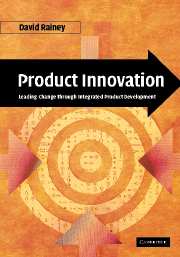Book contents
- Frontmatter
- Contents
- Preface
- Acknowledgements
- Part I Product innovation and strategic logic
- Part II Establishing the foundation: the conceptual level
- 4 Identifying new-product opportunities: Idea Generation (Phase 1)
- 5 Concept Development and Selection (Phase 2)
- 6 NPD Program Definition (Phase 3)
- Part III Methods and techniques for analysis and decision making
- Part IV The operational level and concluding remarks
- Glossary
- References
- Select bibliography
- Index
4 - Identifying new-product opportunities: Idea Generation (Phase 1)
Published online by Cambridge University Press: 10 August 2009
- Frontmatter
- Contents
- Preface
- Acknowledgements
- Part I Product innovation and strategic logic
- Part II Establishing the foundation: the conceptual level
- 4 Identifying new-product opportunities: Idea Generation (Phase 1)
- 5 Concept Development and Selection (Phase 2)
- 6 NPD Program Definition (Phase 3)
- Part III Methods and techniques for analysis and decision making
- Part IV The operational level and concluding remarks
- Glossary
- References
- Select bibliography
- Index
Summary
Introduction
Exploring new-product opportunities involves the generation, development, and evaluation of ideas for new products. The fundamental steps include understanding the needs for new products, discovering existing and potential sources of ideas, describing internal and external requirements, and assessing the opportunities. The steps include reflecting on goals and priorities, examining guidelines, resolving problems and conflicts, evaluating ideas, and selecting candidates for further development.
Idea generation represents the genesis of the new-product development (NPD) process. While new-product development is a continuum in many organizations with ideas constantly flowing from individuals, teams, and business units, the Idea Generation Phase is the formal starting point of the NPD process where the ideas are identified, assessed, evaluated, ranked, and screened. New-product ideas are obtained from every facet of the business environment and the organization.
The exploration of new-product opportunities requires an extensive study of external business conditions and trends including understanding market needs and wants, and stakeholder expectations. It also requires a thorough assessment of the internal strengths and weaknesses with respect to the existing product portfolio and capabilities. Occasionally, luck plays a role as well; ideas simply become apparent or occasionally mistakes in the laboratory turn into opportunities. 3M's Post-it Notes are an example of a product line that evolved from the failure to develop a super adhesive. The semi-sticky substance that resulted from the experiments became the perfect material for making detachable notes.
- Type
- Chapter
- Information
- Product InnovationLeading Change through Integrated Product Development, pp. 149 - 188Publisher: Cambridge University PressPrint publication year: 2005
- 1
- Cited by



